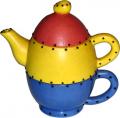A tea cup is a small cup made for drinking, typically made of porcelain. Tea cups made from stoneware are also available, but are not as common. A tea cup may have a handle, and is usually able to be grasped by the thumb and one or two fingers.
A tea cup usually features decorations around the sides.
European tea cups usually come with a set, along with a matching saucepan.
Asian tea cups typically come without a handle and also without a saucepan, although they may come with a covering lid.
European tea cups
The first tea cups made their way to Europe in the 17th century from China. Europeans found these cups difficult to handle, finding them too hot and the shallow bowls too messy.
Modern European tea cups are usually taller than their base, and usually come with a matching saucer. Some tea cups come along with an entire tea set, including the teapot, sugar holder, milk jug and spoons.
The handle is normally set high on the side of the cup, and usually has a delicate appearance. The handle is usually large enough to accommodate the user's thumb and finger.
The best European tea cups are made from fine porcelain and have a strong, but delicate appearance. The best European tea cups should be translucent when held to the light, yet strong enough to easily hold a full cup of tea.
Asian tea cups
Asian tea cups are usually smaller than European tea cups, and also lack a handle. The cups are designed so that the user grips the entire cup with their hand. As they are made for the entire hand, the walls of the tea cup are thicker than their European counterparts.
Asian tea cups may vary according to country. Chinese tea cups are generally porcelain and are rarely made of stone. Japanese and Korean tea cups may be made from porcelain or stone.
Collectible tea cups
Tea cups are quite collectible, due to their size and designs. Tea cup collections vary widely, with some people collecting tea cups due to a similar design motif, while others may collect tea cups made from a certain company.
Some collectors may collect tea cups to match certain rituals. Examples include the Japanese and Korean tea ceremonies, where tea cups may vary according to both the theme and the season. Summer tea cups, for instance, may be smaller and shallower than tea cups used for autumn and winter rituals, and may be decorated differently.
European tea cups are collected both according to their appearance and their quality. Some collectors enjoy having tea cups depicting a certain subject. Other collectors may judge by the quality of a tea cup. Some European tea cups are collected as future investments, such as tea cups made by the Royal Doulton Company. Royal Doulton is known for their fine bone china.
